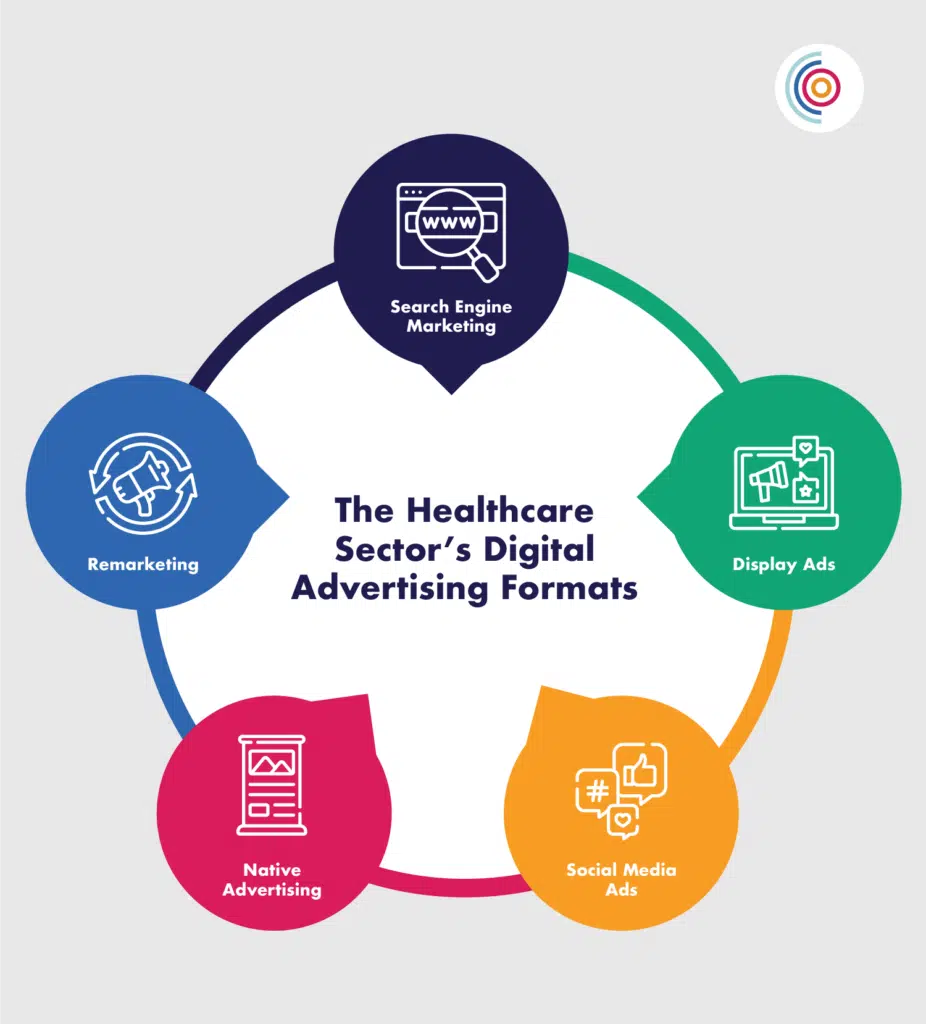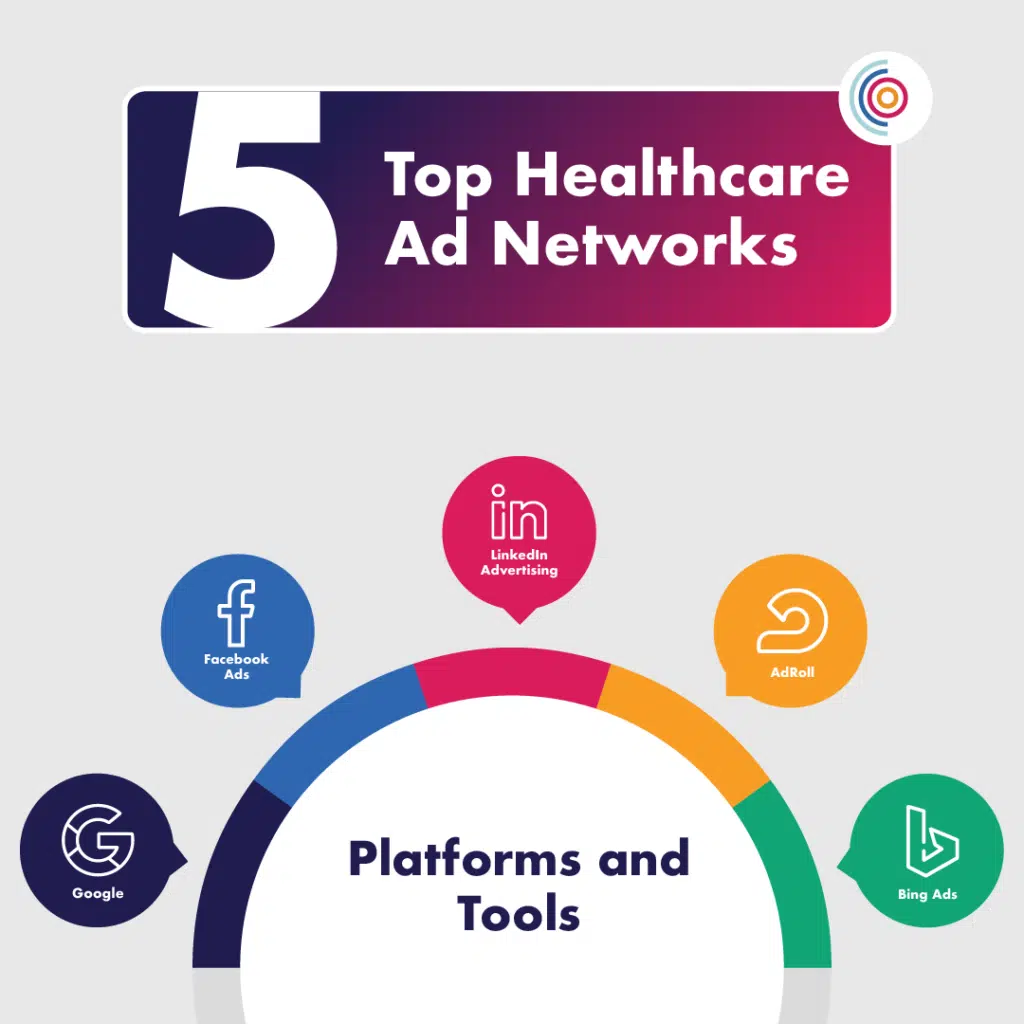While savvy marketers and healthcare executives should explore and consider a range of channels to distribute their messaging, one area that certainly cannot be overlooked is digital advertising. The popularity of digital advertising has exploded in recent years with more than 600 billion dollars spent on the medium each year. The rise of digital advertising is no surprise for those who are already taking advantage of it as its benefits are simply unmatched when it comes to maximizing budget and reach.
Among the many benefits of digital advertising, the channel is known for:
- Digital advertising is relatively inexpensive and has an extremely low cost of entry. (you can start for as little as a few dollars a day.)
- Digital advertising can be extremely strategic and targeted. You can serve your advertisements to exactly the audiences you want and not waste your budget on other demographics.
- Digital advertising is extremely scalable. You can test your messaging and creative assets to quickly and easily scale what’s working and cut what’s not.
- Digital advertising is extremely measurable.
With that said, you should be excited to get started with digital advertising. This blog will explain some of the basics and how to get started.

Determine the type of digital advertising you want to run.
There are many different types of digital advertising. Read this blog to learn about five important types of digital advertising.
- Search Engine Marketing (SEM): SEM involves placing ads on search engine result pages to drive website traffic. This format is highly effective as it targets users who are actively searching for specific products or services. Pay-per-click (PPC) is a form of SEM where advertisers pay each time their ad is clicked by a user. This format allows for better cost control and targeting options.
- Display Ads: Display ads are the standard ads you see on millions of websites around the internet. They often take the form of static images or short gifs. Think of those square ads you may see in the middle of a news article. They are designed to be visually appealing with limited text They come in various sizes and shapes, including leaderboard banners, skyscraper ads, and pop-up ads.
- Video ads: Video ads are simply video ads that you will see either before, during, or after a video you want to watch. The most common place to see video advertising is on Google-owned YouTube, however, video advertising is common on many websites including news sites
- Social Media Ads: Social media is one of the most popular places to run digital advertising. These ads are often essentially display or video advertising, but rather than running on websites, the ads will run on social media platforms including Facebook, Instagram, and LinkedIn among others.
- Product Ads: product ads are popular for companies that sell widgets. You may see sponsored product ads on Amazon or on Google’s Shopping tab. Product ads are designed to elevate your products above others to people looking to buy now.
Choosing a Digital Advertising Platform – Top Ad Networks for Healthcare Organizations

There are a number of tools, technologies, and platforms that can facilitate and automate your digital marketing. If you don’t know where to start, here are some of the most popular ones.
- Google Ads Network: As the leading search engine, Google offers a wide reach and advanced targeting options for healthcare organizations. Advertisers can target specific keywords related to their services and even target users based on their location, interests, and online behaviors. Google also has a leading display network and because they own YouTube, their video advertising platform is extremely popular as well. Google also provides product marketing capabilities for customers who sell widgets.
- Meta Ads Network: Arguably the top network alongside Google is Meta, which serves ads to the extremely popular websites/apps Facebook and Instagram. The Meta Ads platform provides a diverse selection of targeting options, including demographics, retargeting, lookalike audiences, interests, and behaviors. This platform is especially valuable for healthcare organizations as it enables precise targeting based on health-related interests or activities.
- LinkedIn Advertising: Designed for B2B healthcare organizations, LinkedIn Advertising stands as an excellent choice. Leveraging its professional audience and advanced targeting capabilities, businesses can effectively reach decision-makers and industry professionals within the healthcare sector.
- AdRoll: As a retargeting ad network, AdRoll allows businesses to reconnect with individuals who have previously visited their website or engaged with their brand online. This proves particularly advantageous for healthcare organizations aiming to maintain top-of-mind awareness among potential patients.
- Bing Ads: While Bing may have a smaller audience compared to Google, Bing Ads serves as a compelling alternative to Google Adsense. This platform remains an effective option for healthcare organizations seeking to target niche markets.
Determine Your Audience For Maximum Success
One of the greatest advantages of digital advertising is its ability to target specific audiences precisely. Unlike traditional advertising methods, digital advertising offers a more targeted and focused approach. This empowers digital advertisers to connect with potential patients or businesses who are genuinely interested in your services. There are several options available for targeting your audience through digital advertising, including:
- Demographic Targeting: This strategy involves tailoring your ads based on factors like age, gender, education, income, and healthcare requirements. For instance, if you’re promoting a healthcare service, you can target your ads to reach women aged 40-60 with higher income levels and a history of healthcare-related searches.
- Behavioral Targeting: This approach allows you to target individuals based on their online behaviors and preferences. In healthcare, for example, you can use behavioral targeting to deliver personalized health-related content to users who have demonstrated interest in a specific medical condition or wellness topic.
- Interest-Based Targeting: With this option, you can focus on individuals based on their interests and online behaviors. As a pediatrician, you can specifically target parents or expectant parents who have shown an interest in healthcare topics or have engaged with healthcare-related content online.
- In-Market Targeting: Platforms like Google allow companies to target potential customers based on several factors that may suggest they are in-market or ready to buy a new product.
- Geographic Targeting: You can also target your ads based on geographical location, such as city, state, or country. This is particularly advantageous for healthcare organizations with a specific service area. For example, a local hospital can direct its ads to reach people in the surrounding cities and towns they serve.
- Website retargeting: One of the most powerful ways to use digital advertising includes serving ads to individuals who visited your website or specific pages on your website. If you’ve ever looked at a pair of shoes online, only to go to another website and see those same shoes in an advertisement, then you understand the effectiveness of website retargeting. Website retargeting involves adding a bit of code to your website and it can be affected by the user’s privacy and security settings.
- Lookalike or similar lists: Another great audience selection strategy that digital advertising networks provide is lookalike or similar lists. This includes providing user data (often through a website pixel or customer email list) to the advertising network. The network will then find similar users based on their browsing history and other factors. If you ever shopped for a new vacuum, for example, only to be served an ad showcasing another vacuum, then you’ve been the target of a similar or lookalike targeting strategy.
By leveraging these targeted options, your digital advertising campaigns can be more effective and efficient in reaching the right audience for your healthcare services.
Types of Data Sets for Audience Targeting
As mentioned above there are several ways to use data in targeting your audience. There are three primary types of data sets at your disposal: first-party, second-party, and third-party data.
First-party data is information you collect directly from your audience or customers. This could include data from behaviors, actions, or interests shown across your website or app. It could also include information from CRM systems, subscriptions, surveys, and other direct customer-related interactions. In a healthcare context, this may cover patient demographics, appointment history, or treatment preferences.
Second-party data is essentially someone else’s first-party data that they sell to you directly. It’s gathered in the same way as first-party data. However, it originates from a different source which you form a partnership with. For instance, as a healthcare provider, you might partner with a fitness app to gain insights into users’ workout habits and health metrics.
Third-party data is data you buy from outside sources that are not the original collectors of that data. These data sets are collected from a variety of websites and platforms, providing a broad spectrum of customer habits and trends. For healthcare organizations, third-party data could provide insights into broader health trends and common health concerns in various demographics.
Each data type has its strengths and can be leveraged depending on your specific advertising goals. While first-party data is highly reliable and specific, second and third-party data can provide a broader view, helping you to capture new potential markets. The key is to understand your audience and what data sets will best support your advertising efforts.
Choosing the Right Message and Creative for Your Ad
The content of your ad is just as important as the platform you choose. Here are some popular content types of ads to consider:
- Image Ads: These are simple and visually appealing ads that use images to grab the attention of your target audience.
- Video Ads: Videos are a great way to engage with your audience and showcase your services in an interactive way.
- Text Ads: These are simple and straightforward ads that use text to convey your message. They are commonly used for search engine advertising.
- Carousel Ads: Carousel ads allow you to showcase multiple images or videos in one ad, making it ideal for showcasing different services or products.
- Interactive Ads: These ads use interactive elements such as quizzes, games, or polls to engage with the audience and promote your services.
The Power of Ad Networks: Connecting Advertisers and Publishers for Effective Reach
An advertising network serves as a bridge between advertisers and publishers, facilitating the utilization of available ad space. These networks provide a plethora of services, including targeting options, strategic ad placement, and comprehensive reporting tools, empowering businesses to effectively reach their desired audience.
Ad networks are crucial players in the digital advertising ecosystem. They have a pivotal role in collecting unsold ad inventory from online publishers and matching it with advertisers in need of ad spots. This smooth process fosters efficient interaction and paves the way for successful deals. There are four primary types of ad networks:
- Vertical Ad Networks: These networks specialize in a specific industry or niche, such as healthcare. They offer targeted ad placements on relevant websites and platforms, maximizing the chances of reaching the desired audience.
- Targeted Ad Networks: These networks focus on specific user demographics, behaviors, interests, or locations. This enables advertisers to target their ads towards a particular audience, increasing their relevancy and effectiveness.
- Horizontal Ad Networks: These networks offer a wider range of ad placement options, covering various industries and niches. They focus on delivering high volumes of impressions across a large number of websites.
- Premium Ad Networks: These are exclusive networks that only work with top-tier publishers and advertisers. The quality of ad placements is usually higher in these networks, making them an ideal choice for businesses that want to advertise on premium websites and reach a more affluent audience.
Demystifying Ad Network Costs: Factors, Models, and ROI
Using ad networks can have a wide range of costs. It all depends on factors like the network’s reach, audience targeting capabilities, and the quality of ad placements. Vertical and targeted ad networks tend to be pricier because they focus on specific audiences, while horizontal networks are usually cheaper since they have a broader approach. Premium ad networks can be the most expensive, but they give you access to top-tier publishers and attract a more affluent audience.
The pricing models used by ad networks also affect the costs. There are two common models: cost per click (CPC) and cost per thousand impressions (CPM). CPC charges per click on ads, while CPM charges per thousand ad impressions. These models impact the overall cost of using ad networks.
Real-time bidding (RTB) has also made ad network pricing more dynamic. With RTB, advertisers bid in real-time for ad inventory, which can influence the cost of placements. Ad networks that use RTB may have fluctuating prices based on demand and competition for ad space.
Keep in mind that although these costs can be higher, businesses often find them valuable because they lead to improved ad performance and higher conversion rates. Remember, the key to successful digital advertising is finding the right balance between cost and return on investment.
By understanding the distinct features of these ad networks, you can make an informed decision and optimize your digital advertising strategy. Choose the platform that aligns best with your goals and target audience to maximize your advertising efforts.
Partner with Conway Marketing Group
While digital advertising can seem overwhelming, partnering with a trusted marketing agency like Conway Marketing Group can make a significant difference in the success of your healthcare organization. Here’s why:
- Expertise and Experience: With years of experience in digital advertising, Conway Marketing Group has the expertise to create effective ad campaigns that target the right audience and deliver results.
- Industry Knowledge: As a specialized healthcare marketing agency, Conway Marketing Group understands the unique challenges and needs of healthcare organizations, making them well-equipped to create tailored digital advertising strategies that align with your goals.
- Customized Solutions: Conway Marketing Group takes the time to understand your specific needs and goals and develops customized solutions that fit your budget and deliver maximum impact.
- Data-driven Results: With advanced analytics tools, Conway Marketing Group continuously monitors the performance of your ad campaigns and makes data-driven decisions to optimize them for better results.
- Comprehensive Services: From ad design and copywriting to targeting and placement, Conway Marketing Group offers comprehensive services that cover all aspects of digital advertising, saving you time and resources.
- Continuous Support: Partnering with Conway Marketing Group means having a dedicated team of experts who are always available to answer your questions, provide support, and constantly improve the performance of your ad campaigns.
While digital advertising can be beneficial for businesses of all industries, it can be particularly impactful for healthcare organizations. With an ever-growing online presence and an increasing need for digital communication, healthcare organizations can benefit greatly from digital advertising. With the help of Conway Marketing Group’s tailored solutions and expertise in the industry, healthcare organizations can successfully navigate the digital landscape and reach their target audience effectively. So don’t wait any longer; start your digital advertising journey today and see the positive impact it can have on your business. So why not take the first step and get started with digital advertising today? Contact us to learn more about our services and how we can help your healthcare organization succeed in the digital world.
Sources:



